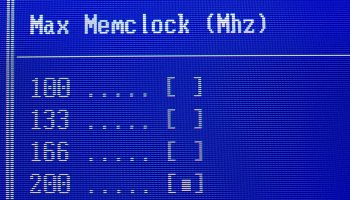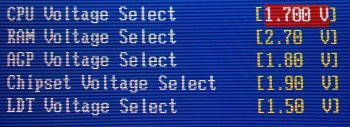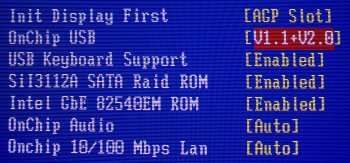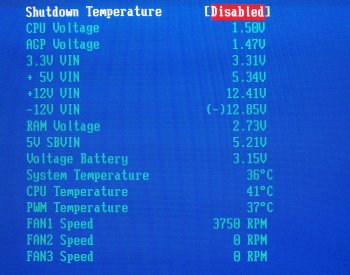Shuttle AN50R (nForce3) BIOS
The Shuttle AN50R's BIOS gives off an EPoX-like feel.


The majority of present K7-series motherboards support multiplier adjustment and DRAM latency adjustment. Both factors are missing from this Shuttle. That's also the case with the K8T800 EPoX 8HDA3+, too. CPU MHz go up from 200 - 300MHz. With a 10x multiplier that's 2GHz - 3GHz in 10MHz increments. Rather wishful thinking if the multiplier cannot be manipulated. DRAM settings, like the EPoX board, take the form of a maximum memory frequency at a given CPU MHz. At the Athlon 64 3200+'s native 2GHz, this translates to a perfect 200MHz (DDR400, 10x divisor). Other frequencies are less clear cut. It's not now a case of keeping the memory frequency synchronous to the FSB. Every memory speed with conventional memory is asynchronous. If you can find RAM that will run at the full 2000MHz, (DDR4000, PC32000), please let us know forthwith. The AGP speed setting seems to infer a speed-locking feature. It's not clear here that a PCI lock is in place, but every chipset should really ship with it in place. Separate clock controllers allow it, it should be implemented each and every time.
NVIDIA has revised the speed of AMD's HyperTransport link between CPU and chipset. Ideally running at 3.2GB/s in each direction, NVIDIA, seemingly, has scaled it down to 1.2GB/s from the chip to the CPU and 2.4GB/s in the other direction. That's plenty of headroom for current devices, but running at full speed may prove beneficial in the near future. VIA likes to publicise the fact that its Hypertransport link runs at full speed. That's great, except that the bus between the bridges is a meagre 533MB/s. Remove the slowest bottleneck first, please.


Voltage-wise, the maximum values are shown on the left-hand shot (RAM is 2.90v. incidentally). A broad range of voltages that are quite consistent under load. Our limited time with the Clawhammer reveals that it's not all that partial to extremely high voltages. Vcore is limited to a sensible 1.7v. Shuttle's attempts at making the board feature rich manifests itself in a number of controllers. Options shown on the right.

Pretty strong voltages on all lines, really. The CPU is a lukewarm 41c with a reference, quiet AMD cooler sitting atop. Shutdown temperatures can be set to either 60, 65, or 70c. It's actually quite difficult to get it that high, if BIOS' readings are to be believed. A pretty good effort from Shuttle. What we'd like is a method of controlling each fan's speed through various BIOS-related settings, much in the vein of ABIT.









